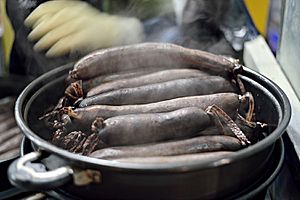Sundae (sausage) facts for kids
 |
|
| Type | Blood sausage |
|---|---|
| Course | Street food |
| Place of origin | Korea |
| Associated national cuisine | Korean cuisine |
| Korean name | |
| Hangul |
순대
|
|---|---|
| Revised Romanization | sundae |
| McCune–Reischauer | sundae |
| IPA | [sun.dɛ] |
Sundae (Korean: 순대 [sun.dɛ], sometimes anglicized as soondae) is a popular Korean dish. It's a type of sausage, often called "blood sausage," and is a favorite street food in both North and South Korea. It's usually made by steaming cow or pig intestines filled with different ingredients.
Contents
History of Sundae
Sundae has a long history in Korea. It first appeared during the Goryeo period (from 918 to 1392). Back then, people often used wild boar meat to make it. Recipes for sundae can be found in old cookbooks from the 1800s, like Gyuhap chongseo and Siuijeonseo.
Traditional sundae was a special treat. It was made with cow or pig intestines stuffed with seonji (blood), minced meat, rice, and vegetables. People ate it during special events, parties, and big family get-togethers.
After the Korean War, meat became hard to find. So, in South Korea, dangmyeon (glass noodles) started to replace the meat fillings. This made sundae an inexpensive snack. You can now find it sold in snack bars called bunsikjip, street stalls called pojangmacha, and traditional markets.
Types of Sundae
Traditional sundae in South Korea, North Korea, and other Korean communities often includes seonji (blood), minced meat, rice, and vegetables. However, modern South Korean snack-style sundae often uses dangmyeon (glass noodles) instead of meat or rice. Other fillings can include kkaennip (perilla leaves), scallions, doenjang (soybean paste), kimchi, and soybean sprouts.
There are many regional types of sundae:
- Abai-sundae (아바이순대) comes from the Hamgyong and Pyongan Provinces.
- Kaesong-sundae (개성순대) is from Kaesong.
- Baegam-sundae (백암순대) is from Yongin.
- Jeju-sundae (제주순대) is from Jeju Island.
- Byeongcheon-sundae (병천순대) is from Chungcheong Province.
- Amppong-sundae (암뽕순대) is from Jeolla Province.
Some sundae types even use seafood as the casing!
- Ojingeo-sundae (오징어순대) is made with fresh squid. It's a special dish from Gangwon.
- Mareun-ojingeo-sundae (마른오징어순대) uses dried squid. You can find it in Gangwon and Gyeonggi.
- Myeongtae-sundae (명태순대) is made with Alaska pollock. It's a local favorite in Gangwon and Hamgyong.
- Eogyo-sundae (어교순대) is made with the swim bladder of brown croakers.
How Sundae is Eaten
In South Korea, sundae is often steamed and served with other steamed parts like gan (liver) and heopa (lung). People usually dip sliced pieces of sundae and these side dishes into different sauces.
The dipping sauce changes depending on the region:
- In Seoul, people use a mix of salt and black pepper.
- In Honam, it's a mix of vinegar and gochujang (chili paste).
- In Yeongnam, they use seasoned soybean paste.
- In Jeju, it's soy sauce.
Sundae is very popular at guk-bap restaurants (soup restaurants) and bunsikjip (snack bars). Since it's often sold alongside tteok-bokki (stir-fried rice cakes) and twigim (fritters), many people also dip sundae in tteok-bokki sauce. Many snack bars offer a special set menu called tteok-twi-sun, which includes tteok-bokki, twigim, and sundae.
Sundae Dishes
Sundae is also used as a main ingredient in other delicious Korean dishes:
- Sundae-guk (순대국) – This is a guk (soup) made with sundae, other inner parts, and meat. It's a warm and hearty meal.
- Sundae-bokkeum (순대볶음) – This is a bokkeum (stir-fry) dish. It's made by stir-frying sundae with vegetables and gochujang (Korean chili paste).
- Baek-sundae-bokkeum (백순대볶음) – This is a version of sundae-bokkeum but without the gochujang. It has a milder flavor.
Images for kids
-
Traditional sundae (blood sausage) served with steamed offal
-
Sundae-guk (blood sausage soup) served in ttukbaegi
See also
 In Spanish: Sundae (embutido) para niños
In Spanish: Sundae (embutido) para niños







